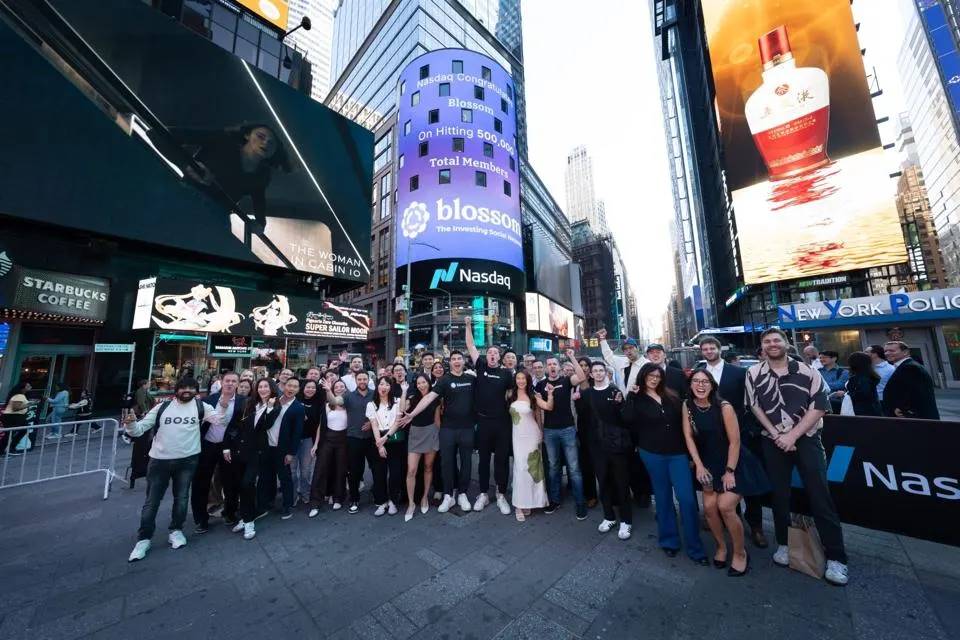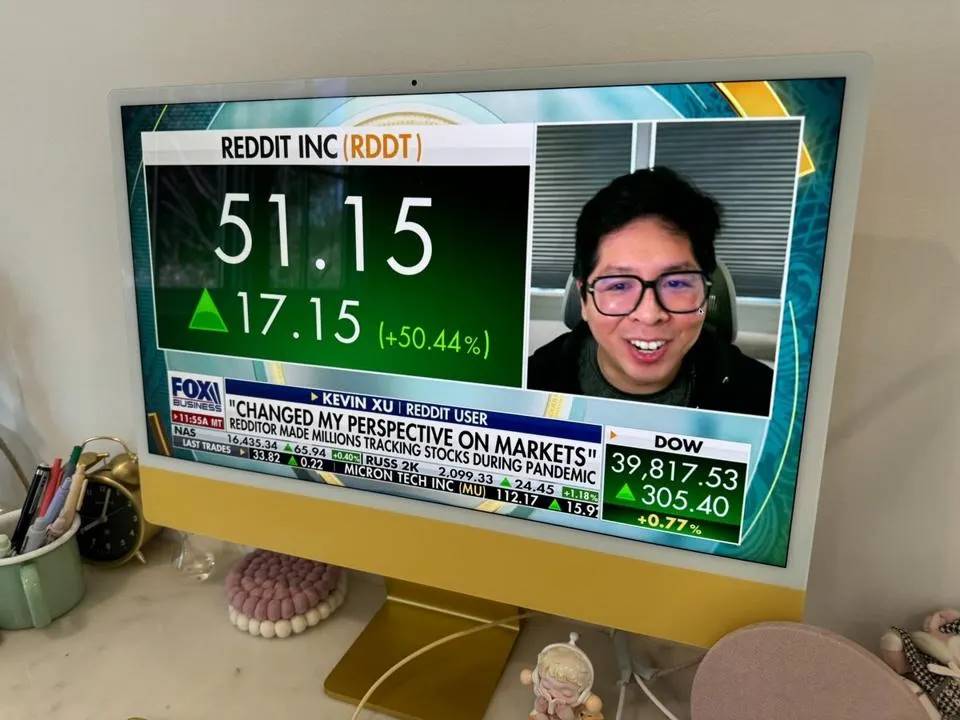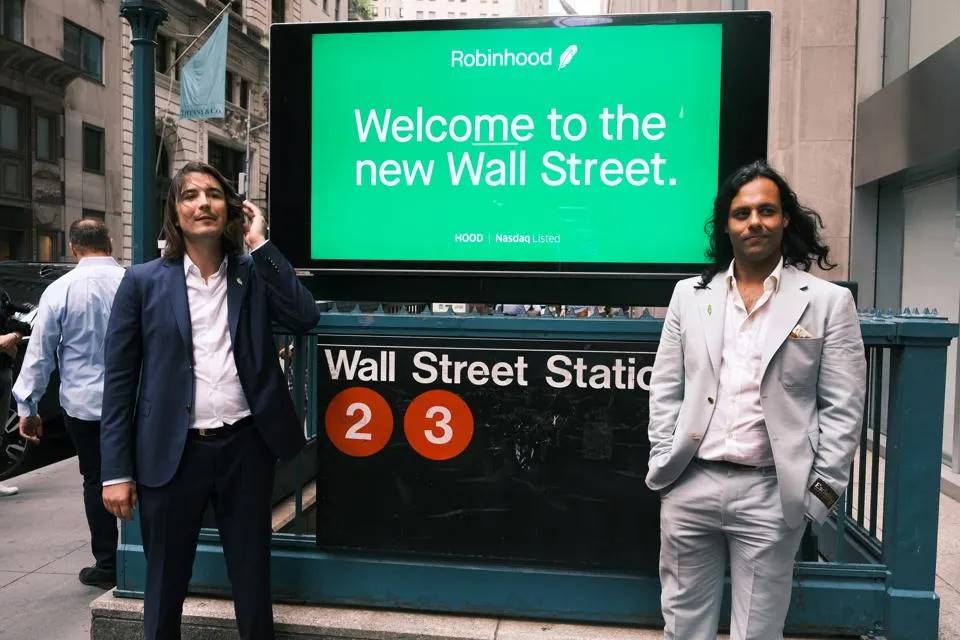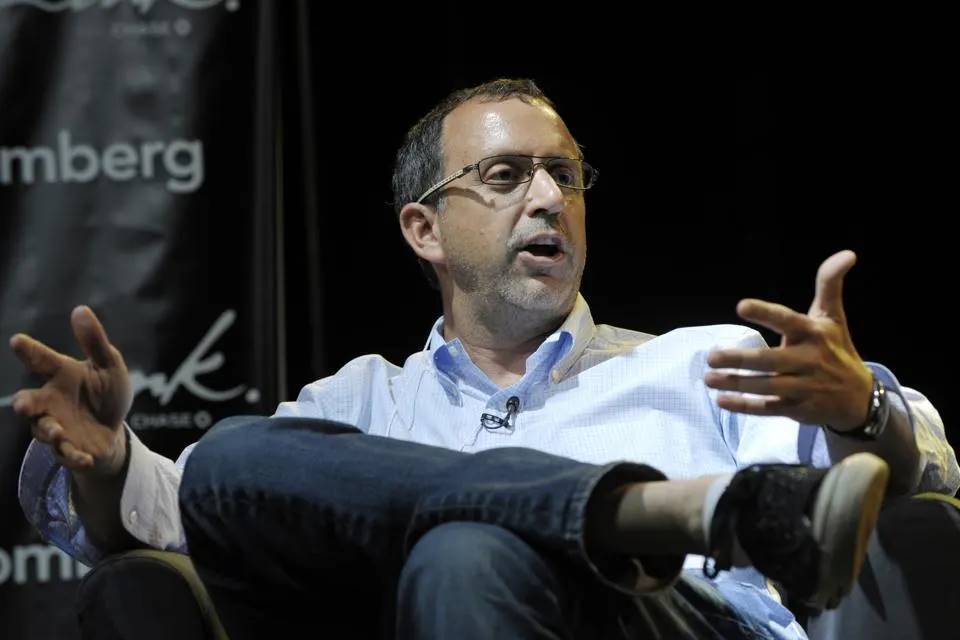Author: Boaz Sobrado
Translation: TechFlow

On January 23, 2025, the dog from the famous "Dogwifhat" meme—Achi—appeared at the New York Stock Exchange (NYSE) opening bell ceremony.
Dogwifhat (token symbol: WIF) is a dog-themed meme coin based on the Solana blockchain, launched in November 2023. Its mascot is a Shiba Inu wearing a knitted hat.
Image source: TIMOTHY A. CLARY / AFP, provided by TIMOTHY A. CLARY/AFP via Getty Images
When Benchmark led the $17 million Series A round for Fomo in November 2025, this most selective Silicon Valley VC made an unusual bet in the crypto space. Benchmark rarely invests in crypto startups. Although it supported Chainalysis in 2018 and a handful of other crypto companies, crypto is not typically part of its portfolio. However, partner Chetan Puttagunta chose to join Fomo’s board. Fomo is a consumer app that supports trading millions of crypto tokens across multiple blockchains.
Benchmark’s investment was not just about another trading app. They were betting on the rapidly emerging field of "social trading infrastructure," which is gradually becoming as indispensable to retail investors as brokerage services.
More Than Just Speculators: The Blossom Social Case Study

The Blossom Social team and community members pose in front of Nasdaq
Image source: Blossom Social
Blossom CEO Maxwell Nicholson has a deeper understanding of "user friction" than most. When you create a social platform and require users to link their brokerage accounts during registration, it undoubtedly creates a significant barrier early in the user journey. Most consumer companies would choose to remove such a hurdle, but Blossom made it mandatory.
This decision seems counterintuitive until you understand Nicholson’s vision. Blossom launched in 2021, during the retail trading frenzy sparked by GameStop. At the time, discussions about stocks on Reddit were completely anonymous—you couldn’t see real holdings, only claims and opinions. While StockTwits had already amassed a large user base, most users only shared unverified personal views.
Nicholson wanted to build a social network based on real investments, a goal made possible by recently launched APIs like SnapTrade, which enabled brokerage account verification. The technology was ready—the question was whether users could accept this "friction."
It turned out they could. Today, Blossom has 500,000 registered users, about 100,000 of whom have linked their brokerage accounts, with nearly $4 billion in assets under management. On Blossom, half of users’ assets are in ETFs (exchange-traded funds) rather than individual stocks. The most popular holding is the S&P 500 ETF.
The mandatory brokerage account linking ultimately shaped Blossom’s community culture. Nicholson observed that StockTwits only later introduced brokerage account linking as an optional feature. Although services like Plaid or SnapTrade provided the technical support, StockTwits users did not widely adopt this feature because linking was not part of the platform’s core DNA. On Blossom, nearly all regular posters share their real holdings and earn a special badge through verification. This culture formed precisely because mandatory linking filtered for users willing to share their real portfolios.
This culture ultimately translated into business value. Blossom generated $300,000 in revenue in 2023, $1.1 million in 2024, and this year expects to reach $4 million, with 75% of revenue coming from partnerships with ETF providers.
State Street pays Blossom to raise retail investor awareness of SPY (S&P 500 ETF), to prevent them from defaulting to Vanguard’s VOO. VanEck promotes thematic ETFs, and Global X advertises sector-focused funds. Currently, about 25 different fund providers work with Blossom because the platform can reach retail investors actively choosing which funds to buy.
This business model works because Blossom users discover new investment opportunities through the community. Their goal is not short-term trading, but to build portfolios for the coming decades. When users link accounts and discuss holdings, they not only create content for others but also generate data on real retail behavior.
Nicholson mentions Blossom’s quarterly reports on retail fund flows into ETFs. These data show how retail investors actually use their money, rather than relying on intentions claimed in surveys. The data are credible because of brokerage account verification, and ETF providers are willing to pay for them to see if their products are favored by retail investors.
Currently, the $4 billion in assets linked on Blossom represent real money, and allocation decisions are based on discussions on the social platform. From the ETF provider’s perspective, this is not just an entertainment platform, but critical infrastructure.
Retail Investors Dominate the World, But Which Kind?

Famous Reddit investor Kevin Xu is the founder of AfterHour and Alpha.
Image source: Kevin Xu
The explosion of social trading reveals a fact: retail investors are not a monolithic group. Platforms that succeed in this space serve fundamentally different audiences, with significant differences in risk appetite, investment time horizon, and motivation.
AfterHour targets the WallStreetBets user base. Founder Kevin Xu turned $35,000 into $8 million during the "meme stock" craze, transparently sharing every trade as "Sir Jack" in the WallStreetBets community. He created AfterHour to serve this group. Users can share their holdings under a pseudonym, but must verify their portfolios by linking brokerage accounts. They share real dollar amounts, not just percentages. The stock-based chatroom functions are similar to a trading version of Twitch live streams.
In June 2024, AfterHour raised $4.5 million from Founders Fund and General Catalyst. The platform is clearly popular, reportedly with 70% of users opening the app daily. These are not passive investors who check statements quarterly, but active participants who see the market as entertainment and community. To date, the platform has provided nearly 6 million trading signals to users and verified over $500 million in linked portfolio assets.
On the other hand, Fomo focuses on "crypto degens" chasing cryptocurrencies, people who want access to millions of tokens on every blockchain. The Fomo founders compiled a list of 200 ideal angel investors and leveraged their network to secure introductions, successfully attracting 140 of them, including Polygon Labs CEO Marc Boiron, Solana co-founder Raj Gokal, and former Coinbase CTO Balaji Srinivasan.

The team behind the Fomo app, which recently raised funds from Benchmark
Benchmark’s investment in Fomo came after referrals from three people who had worked with Fomo founders Paul Erlanger and Se Yong Park at dYdX and endorsed their vision: to build a super app that gives users access to all crypto assets on any blockchain, with social features to follow friends’ and leaders’ trades in real time.
The Fomo founders built a platform offering users a 24/7 trading experience—whether it’s bitcoin or obscure meme coins, if it exists on any blockchain, it can be traded. The app charges a 0.5% trading fee but covers users’ on-chain gas costs, which is highly attractive to traders focused on mainstream coins. When you can trade Solana tokens at 3 a.m. on Sunday without worrying about network fees, the limitations of traditional markets become glaringly obvious.
In June 2025, Fomo added Apple Pay support, allowing users to start trading immediately after downloading the app. After this, revenue soared to $150,000 per week, with daily trading volume reaching $3 million. By the end of the September funding round, daily trading volume had climbed to $20–40 million, daily revenue from trading fees reached $150,000, and the user base surpassed 120,000.
This growth validated Puttagunta’s judgment: social trading has evolved from a feature into infrastructure. Platforms supporting social trading are building a permanent architecture for how retail investors discover, discuss, and execute trades.
Blossom, by contrast, intentionally attracts users inclined toward long-term investing, who discuss whether to tilt portfolios toward small-cap value or international stocks. About 37% of holdings are in S&P 500 ETFs, with the remaining 63% covering dividend funds, covered call ETFs, crypto ETFs, fixed income, and single-stock ETFs. Users describe their strategy as "core-satellite": broad market exposure as the core, with thematic investments on the periphery.
The audiences served by these platforms are fundamentally different. Investors linking Blossom accounts to discuss SCHD (Schwab U.S. Dividend Equity ETF) dividend yields are completely different from users trading Trump meme coins on Fomo at midnight. They are all retail investors, but their goals, risk appetites, and relationships with the market are entirely distinct.
The success of these platforms comes from clear audience targeting. Blossom’s mandatory brokerage linking filters for serious investors willing to share real portfolios; AfterHour’s pseudonymous transparency attracts traders seeking credibility without exposing personal information; Fomo’s multi-blockchain access serves crypto natives who see 24/7 trading as the norm. In theory, each platform could serve all retail investors, but they have chosen not to.
The Vision of a Financial Super App

New York, New York—July 29, 2025: Robinhood online brokerage founders Baiju Bhatt (right) and Vlad Tenev stroll down Wall Street on the day Robinhood announced its IPO. Despite the debut, Robinhood Markets Inc. shares fell about 5% on Nasdaq.
Image source: Spencer Platt/Getty Images
Robinhood’s launch of "Robinhood Social" in September 2025 validated the social trading trend from an unexpected direction. When the platform known for democratizing trading commissions decided to add social features, it signaled a structural shift in the brokerage industry.
Robinhood CEO Vlad Tenev outlined the vision at a live event in Las Vegas: "Robinhood is no longer just a trading platform—it’s your financial super app." The new features included AI-driven personalized metrics, futures trading, short selling, overnight index options, and multi-account management. However, the core highlight was Robinhood Social—a trading community embedded within the Robinhood app, offering verified trades and real user profiles.
These features are very similar to what independent social trading platforms already offer. Users can view verified trade records in real time, including buy and sell timestamps. They can discuss strategies, follow other traders, and execute trades directly in the feed. Users can also see the daily P&L, returns, and historical trades of traders they follow over the past year. Each user profile belongs to a real person verified through KYC. Users can even follow politicians, insiders, and hedge funds based on publicly disclosed trades, even if those people don’t use Robinhood.
Robinhood made social features invite-only, signaling its seriousness about the space. With 24 million funded accounts, Robinhood has strong distribution power. It pioneered commission-free trading and spent years defending the payment-for-order-flow model. Now, it’s adding social features because the brokerage industry itself faces increasingly severe commoditization.
Zero commissions are now standard across the industry. Mobile apps are a basic requirement, and fractional share trading is standard. Robinhood’s differentiation in 2015 has now been fully matched by Charles Schwab, Fidelity, and TD Ameritrade. Community and interaction are becoming the new points of differentiation.
Robinhood’s move validates a fact: social trading is no longer just a feature—it’s infrastructure. When the largest retail broker adds social features to compete with specialized platforms, those platforms have proven the existence and importance of this space.
The timing is also defensive. Blossom, AfterHour, and Fomo are winning market attention by targeting specific retail investor segments. These platforms don’t need to be brokers; they connect to existing brokers via API but control the key stages of discovery and discussion—where investors decide what to buy. Robinhood controls trade execution, but if investor discussions and decisions happen elsewhere, it risks becoming a commoditized infrastructure pipe.
The stickiness brought by the social layer cannot be achieved by trade execution alone. If your friends are trading on AfterHour and the investors you respect share insights on Blossom, the cost of switching platforms is much higher than simply moving assets. You lose the community, discussion, and social context for decision-making. Robinhood is well aware of this and is taking action, but in this space, it has shifted from leader to follower.
Social Media Is Becoming Market Infrastructure

Howard Lindzon: How Social Trading Is Reshaping the Retail Investment Ecosystem
On April 14, 2011, StockTwits CEO Howard Lindzon spoke at the Bloomberg Link Empowered Entrepreneur Summit in New York, USA. The summit brought together the most innovative entrepreneurs for a day of discussions with other founders, investors, and potential business partners on how to start, fund, and grow a business.
Photographer: Peter Foley/Bloomberg
Social trading platforms integrate two previously separate functions in retail investing—financial media and market infrastructure—offering a brand-new investment experience.
Imagine how Wall Street professionals work. They pay $24,000 a year for a Bloomberg Terminal. The value of the terminal is not just in data or trade execution, but in its seamless workflow. Professionals can observe market dynamics, read news, analyze charts, chat with other traders, and execute trades—all on the same screen. Bloomberg’s instant messaging is widely used because it’s embedded in the workflow, not forcing users to constantly switch context.
Social trading platforms are building a similar workflow experience for retail investors. Take StockTwits, for example, with 6 million users discussing market dynamics in real time. Founder Howard Lindzon (creator of the "Fallen Economy Index") launched the platform in 2008, years before the current retail trading boom. Community discussions are about what’s happening now, not what CNBC reported three hours ago. During the 2021 GameStop surge, the main battlegrounds were Twitter, StockTwits, and Reddit—not traditional financial media.
Blossom combines this concept with verified portfolio data. When users link accounts and discuss their actual holdings, they create content for others. The platform is both a media property and a data source. ETF providers pay for exposure because retail investors discover funds through social dynamics, not Morningstar ratings or financial advisor recommendations.
AfterHour pushes real-time signals when users you follow make trades. Notifications are instant, creating a sense of urgency that traditional media can’t match. When an investor you respect buys a stock, you see the trade immediately, not hours later in a CNBC recap.
Fomo lets you view other users’ holdings in real time as you trade millions of cryptocurrencies. Social feeds show which tokens are gaining attention—often before mainstream crypto media reports on them. Discovery happens through the community, not centralized editors’ judgments of "newsworthiness," changing how people make investment decisions.
This integration explains why traditional financial media struggle to attract young investors. CNBC uses a broadcast model—hosts discuss stocks, viewers passively watch. The disconnect between media consumption and trade execution adds friction. Young investors don’t watch cable TV or wait for market summaries. They get content on their phones in real time and make decisions in the moment.
Social trading platforms solve this by making media content creation participatory. Users create content through trading and discussion. These platforms are essentially media companies, but the signals are user-generated. This structure reflects how young people consume all media—they don’t distinguish between creating and consuming content. Social trading platforms map this behavior onto financial markets.
The business model also reflects the fusion of media and infrastructure. Blossom’s revenue comes from ETF providers buying exposure, similar to media companies selling ad space. But these ads are combined with verified portfolio data, letting providers see if their products are actually popular and pay based on real performance. AfterHour and Fomo profit from trading fees, similar to brokers earning from trade execution. But these trades happen in a social context, driven by community discovery.
These platforms don’t try to replace CNBC or Bloomberg, but instead replace the fragmented experience of separating financial media consumption from trading. Integration is the core innovation. When discovery, discussion, and execution happen in one workflow without context switching, the platform upgrades from a simple app to infrastructure.
Trading Data Is the Product

Blossom Social once held a major event in Toronto attended by 1,400 people at Rogers Centre (where the Blue Jays lost the World Series in Game 7).
Blossom Social
Social trading platforms generate an unprecedented retail market data set. These data sets are products in their own right, separate from the social features that create them.
Blossom’s $4 billion in linked assets reveal the real behavior of retail investors, not just their intentions. Traditional market research asks investors what assets they hold or plan to buy, but surveys are subject to selection bias, memory bias, and idealized answers. Blossom, by verifying data through brokerage account connections, accurately tracks actual retail holdings.
The company publishes quarterly reports on retail assets under management (AUM) flowing into ETFs. These reports reveal which categories attract new funds and which see outflows. This data matters because retail investors now account for a significant share of market trading volume. In 2021, retail trading activity reached levels that forced institutional investors to adjust strategies. Even after the GameStop craze faded, retail investors remain active.
ETF providers are willing to pay for this data because it shows whether their products are truly favored by retail investors. State Street and Vanguard compete for retail investment in S&P 500 ETFs; VanEck and Global X compete for thematic ETF inflows. Providers need to know if retail investors are actually buying their funds, not just aware of them.
Blossom can provide the answer. When 37% of linked assets are in S&P 500 ETFs, it shows this category matters to investors. When covered call ETFs show strong inflows, it validates demand for yield-oriented products. When crypto ETFs gain adoption, it proves retail interest goes beyond speculative exchange trading. This data comes from verified portfolios, not surveys or focus groups.
AfterHour’s verified portfolio data reveals the difference between stocks actually traded by the WallStreetBets crowd and those just discussed. Many stocks trend on social media but see little retail trading volume. AfterHour can separate noise from signal with real holding data. The $500 million in linked portfolios on the platform represent real money flows after community discussion.
Fomo’s trading data reveals which crypto tokens gain real retail adoption beyond the hype. The platform launched promising access to millions of tokens on all blockchains. Most will fail, but the data shows which tokens attract sustained trading volume and which disappear after brief spikes. This data is valuable for understanding retail behavior in crypto markets.
As retail trading’s share of market activity grows, the value of this data increases. Social trading platforms collect information on investor groups that traditional data providers struggle to track. Retail investors don’t file 13F forms or publicly report holdings. Broker data is siloed and hard to share. Social trading platforms, through account linking, bridge traditional data silos and aggregate data from major brokers for a comprehensive view.
These platforms’ business models work because they profit from information flow, not trading volume. Blossom doesn’t need users to trade frequently, but to share real portfolio data to enhance the value of its data. This model’s incentives differ from commission-based brokers or payment-for-order-flow models that rely on trading frequency.
Additionally, these data products build strong moats. Once ETF providers start relying on Blossom’s quarterly reports for strategy, they become dependent on the data. Once AfterHour shows hedge funds the real dynamics of retail trading, that information is incorporated into investment processes. Social trading platforms are not only infrastructure for retail investors but are becoming key tools for institutions and product providers to understand retail behavior.
Trading Has Become a Consumer Behavior
Social trading infrastructure has now become a permanent architecture for the market. These platforms are segmented by audience, but share the same core traits: verified holdings data, real-time conversation features, and a business model based on transparency, not trading volume.
The technology supporting this infrastructure is irreversible. Broker-connected APIs already exist and will only improve. The ability to verify portfolio data in real time is now widespread, and any platform can leverage it. Thus, the question is not whether social trading infrastructure exists, but which platforms can attract which audiences.
Since the GameStop boom, the retail trading wave has not reversed. Retail investors who opened accounts in 2021 did not close them after meme stocks cooled. Data show retail participation is persistent. These investors need infrastructure that meets their workflow needs—a comprehensive platform that seamlessly integrates discovery, discussion, and trading.
Traditional brokers can add social features, as Robinhood has shown. But native platforms with social at the core and trading integration as an add-on may have structural advantages. Blossom, AfterHour, and Fomo don’t need to be brokers—they connect to all brokers via API. This means users can trade on their preferred platform while engaging with other social communities.
The sustainability of these business models has been proven. Blossom’s revenue grew from $300,000 to $4 million in just two years, proving ETF providers are willing to pay for retail investor access. AfterHour’s daily active user data show social trading can form user habits. Fomo’s trading volume growth shows crypto natives crave trading platforms with integrated social experiences. These platforms are not novelties, but infrastructure that truly meets market needs.
The regulatory environment supports, rather than threatens, social trading infrastructure. Social trading platforms do not hold assets or execute trades; their core is providing community and discussion around verified portfolio data. This structure avoids most of the regulatory complexity brokers face. Instead, these platforms choose to partner with regulated brokers, not compete with them.
The future lies in continued segmentation. More platforms serving specific retail investor niches will emerge. Some will focus on options traders, others on dividend income investors, and others on emerging markets. Each platform will build communities around verified data and integrate trading without becoming brokers themselves.
The key to success is precise audience targeting, not trying to be everything to everyone. Retail investors are not a homogeneous group. Successful social trading platforms will reflect this reality in product design, business model, and community culture. Benchmark’s investment in Fomo validates this approach. The firm did not invest in a platform trying to serve all retail investors, but chose one focused on crypto natives who want to trade millions of tokens with the community.
Social trading infrastructure does not replace brokers, but adds a layer of community, discussion, and discovery on top. This layer is becoming as important as the brokers themselves. The platforms building this layer of infrastructure are creating a permanent market architecture for how retail investors operate.




